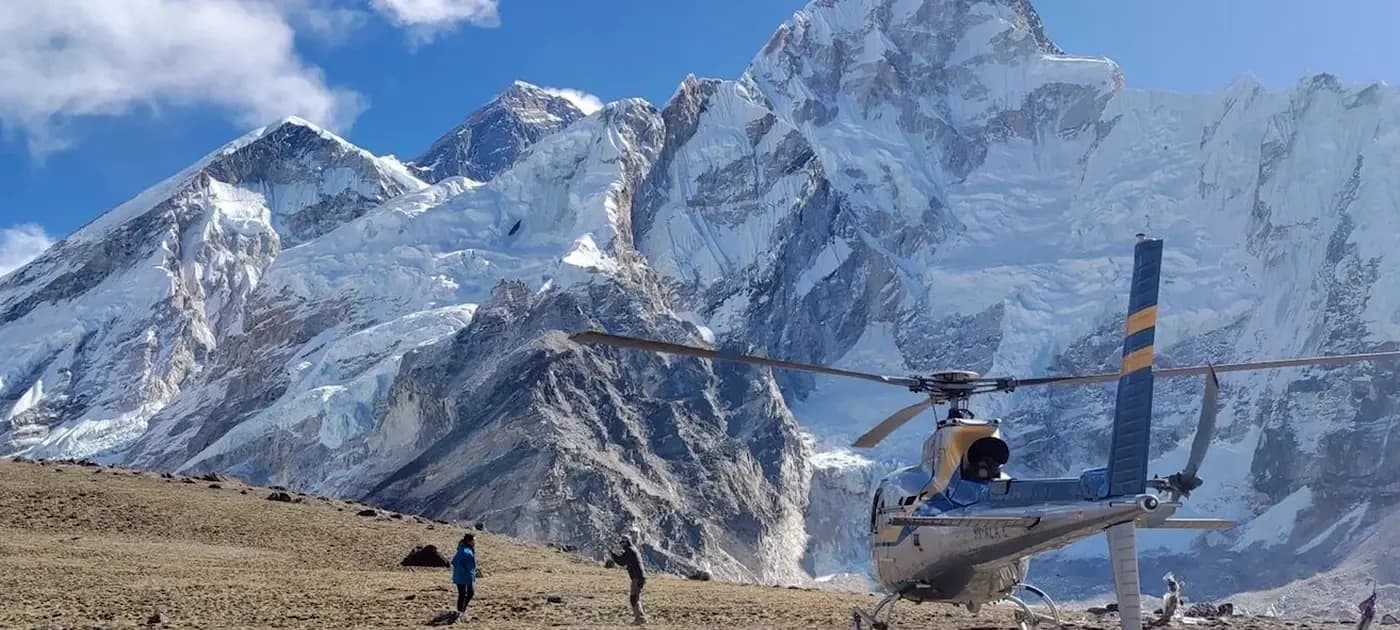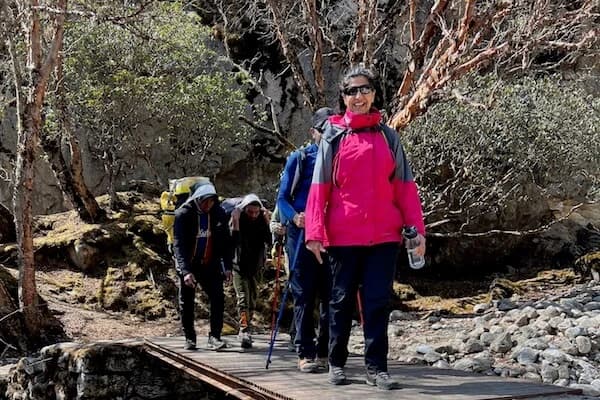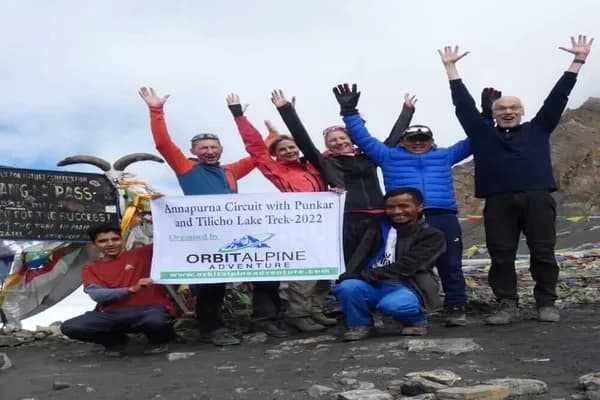The Everest Base Camp trek is one of the world's most popular adventures. Trekkers make their way to the base of Mount Everest every year, but when they arrive, a choice presents itself: trek down or helicopter return?
Both choices yield completely different experiences. Returning by trek allows you to experience additional mountain vistas and cultural encounters, whereas a helicopter return saves days of trekking and gives you an awe-inspiring bird's eye view of the Himalayas. Most visitors ask themselves a simple question: which choice will fit my adventure personality?
Picture soaring above glacial fields and mountains, landing in Kathmandu in an hour. Or picture hiking back through villages and forests, pausing en route to immerse yourselves in local scenery and culture. Whether or not you fly back or hike out can completely alter the way you finish your Himalayan expedition.
Here, we will take you through both options in great detail. You will know time, cost, convenience, security, and overall experience. By the end, you will be ready to decide as to whether a helicopter back or a round-trip trekking adventure is most suitable for your adventurous way of life.
Introduction: Two Ways to End Your Himalayan Journey
Reaching Everest Base Camp is a dream for every trekker. Yet, the journey is not over until you plan how to return. Some follow the traditional method of trekking back, while others helicopter to Kathmandu or Lukla from EBC. Both are adventure-filled, but wildly different. Whether to trek back or return by helicopter depends on your time, money, comfort factor, and adventure level.
What Is a Helicopter Return Trek?
A helicopter return trek means you hike one way up to your destination, such as Everest Base Camp, and then fly back by helicopter. This option combines adventure with comfort.
Many trekkers prefer it when they want to save time or avoid the strain of long descents. Popular routes include the Everest region, Annapurna Base Camp, and Langtang Valley. Flights usually take less than an hour, making them a quick and convenient way to end your trek.

What Is a Round-Trip Trekking Experience?
A round-trip trekking experience means you hike both ways. This is the traditional way of trekking in Nepal and allows you to fully enjoy the mountains and culture. Although it takes more days, it offers a deeper immersion into Sherpa villages, monasteries, and stunning landscapes. It is often the choice of budget-conscious and culture-loving adventurers who want the full trekking experience.
Comparing Time & Convenience
Time is typically one of the biggest factors when planning a trek. A helicopter back is fast and saves days of walking, while trekking there and back is longer but gives a richer and relaxed experience.
Time Savings of Helicopter Return
A helicopter return can save days of walking. Let’s take an example of the Everest base camp trek with a Helicopter return, the trek back from Everest Base Camp to Lukla normally takes 3 to 4 days. By helicopter, the same journey takes less than an hour. This option is perfect for travelers with limited holiday time who still want to experience the Everest Base Camp trek without rushing.
Trekking Pace & Full Immersion
Trekking both ways lets you slow down and enjoy every step of the journey. You see more mountain ranges, cross suspension bridges, and interact with local communities. The longer time on the trail also helps with gradual acclimatization, making the experience healthier and more rewarding for those who enjoy a slower pace.
Cost Factor: Budget vs. Premium Adventure
The price of your return trip can be an influential factor in your decision. A helicopter return provides speed and convenience at a more expensive cost, while trekking both ways is cheaper and is for those with tight budgets.
Helicopter Flight Costs
The helicopter return is an additional premium cost to your trek. Cost ranges from around 500 to 1200 USD per person, depending on season and party size. Sharing flights saves on costs, while chartered private ones are exclusive. The time saved and seeing the country from a different viewpoint are well worth the expenditure for most travelers.
Trekking-Only Budget Planning
If you hike in both ways, you'll spend extra days on food and accommodation in teahouses. But the overall cost is still cheaper than if you include a helicopter flight. A day's food and accommodation costs on average are within reach, so trekking is the best option for tourists who want their trip to be cost-effective.
Comfort, Safety & Physical Demands
Coming back by trekking is strenuous, especially after climbing to great heights. Leg aches, exhaustion, and altitude sickness could pose challenges even to experienced trekkers. Helicopter return reduces physical strain and can even be employed as an evacuation during an emergency when needed.
Qualification of pilots and strict safety guidelines make helicopter travel secure, though weather conditions sometimes cause delays.
Scenic Experience: Ground Views vs. Aerial Panorama
Both the treks and the helicopter transport give you the breathtaking Himalayan scenery, but in such different ways. Walking through the trails lets you connect intimately with villages, forests, and mountain landscapes, but a helicopter flight gives you a panoramic bird's eye view of peaks and valleys below.
Trekking Landscapes & Village Encounters
Walking back on foot lets you connect closely with the Himalayan environment. You pass through Sherpa villages, visit monasteries, and enjoy changing landscapes from glaciers to forests. The cultural experience adds a special depth to the journey.
Aerial Views of the Himalayas
Flying by helicopter gives you a unique bird’s eye view of Mount Everest, Ama Dablam, and many other peaks. You see glaciers, rivers, and valleys spread out below you. This panoramic view is one of the highlights of choosing a helicopter return.
When Weather Impacts Your Experience
Both helicopter flights and trekking are weather-dependent. Treks may be postponed or slowed down due to rain, snowfall, or landslides. Helicopter flights may be cancelled or delayed due to poor weather or wind gusts. A good trekking agency in both cases will incorporate backup plans.
Environmental Impact & Sustainability
Eco-conscious travelers often consider the environmental footprint of their choices. Trekking both ways has a smaller carbon impact, though it puts more pressure on trails and villages. Helicopters produce emissions, but reduce the number of days trekkers spend using local resources. Both have trade-offs, and responsible travel practices can reduce the impact.
Which Option Fits Different Adventure Styles?
Every trekker has a different travel style. Some want comfort and speed, while others enjoy tradition and cultural immersion. Choosing between a helicopter return and a round-trip trek depends on what kind of adventure you are looking for.
Helicopter Return Suits Time-Conscious & Luxury Travelers
If you have limited time, a helicopter return is ideal. It is also popular with couples, executives, and older trekkers who want comfort and exclusivity. Families with children also find it convenient.
Round-Trip Trekking Suits Traditionalists & Budget Trekkers
If culture, determination, and shoestring vacations are what you love, then trekking return is perfect. Gap year travelers, backpackers, and traditional tourists prefer to enjoy this immersive type of vacation.
How Orbital Pine Adventure Helps You Choose
At Orbital Pine Adventure, we customize treks to match your preferences. Whether you want a helicopter return or a full round-trip trek, our expert guides handle permits, safety, and comfort. We ensure your Himalayan journey is smooth, memorable, and tailored to your adventure style.
FAQs - Helicopter Return vs Round-Trip Trekking
How long is a helicopter return versus trekking?
A helicopter return would be under an hour, while trekking back would cost 3 to 4 days depending on the route.
Is a helicopter return safe in the Himalayas?
Yes. Trained pilots operate the helicopters under strict safety protocols. Weather, though, would occasionally hold up the flight.
How costly is a helicopter return?
Prices vary depending on season and group size, around 500 to 1200 USD per person.
Do I need permits for a helicopter return hike?
Yes. The same permits apply for hiking back or helicopter travel, e.g., TIMS and national park permits.
Can I book a helicopter return at short notice?
It is occasionally possible if there is room, but pre-booking is strongly recommended to save disappointment.
What if the weather cancels my helicopter flight?
You may have to wait for clear weather or trek back. A good trekking agency, such as Orbital Pine Adventure has contingency plans.
Is it preferable for acclimatization to trek back?
Yes, trekking back acclimatizes your body step by step. However, a helicopter ride is safe after you are well-acclimatized.
Is a helicopter or trekking preferable for photography?
Both are wonderful. Helicopter flights provide stunning aerial photos, while trekking offers ground-level natural and cultural photography.
Is a helicopter return available for older tourists or families?
Yes, it's favored by older trekkers and families who want the Everest experience but not the physical exertion of trekking back.




